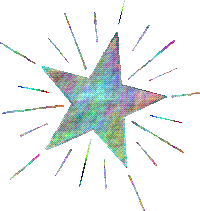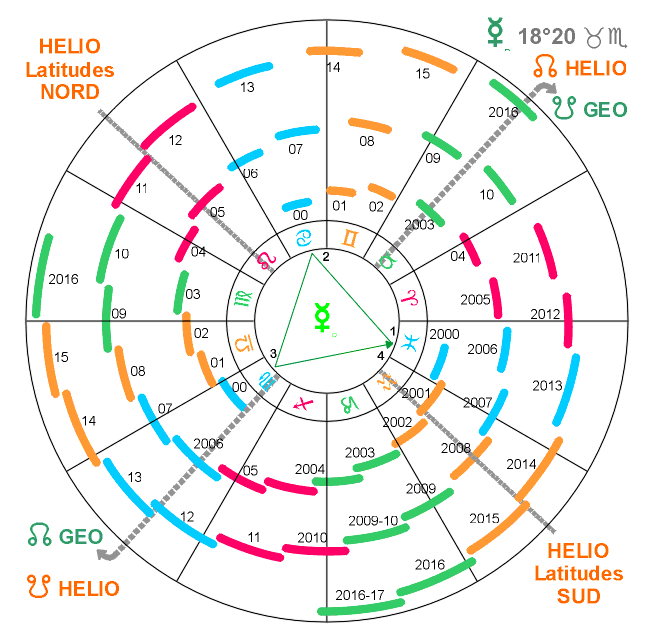|
The Passage of Venus in the face of the Sun - 8 June 2004 |
|||
|
|
|||
The Inferior Conjunction The Sun-Venus inferior conjunctions always occur in the Venus retrograde phase, and that happens every 19 months (or 1,6 years), the synodic cycle, or combination of the Sun-Venus-Earth cycle. The drawing on the right, shows that the Sun-Venus R phase makes a grand split of 216°, between each of them, and five of them shape a 5 branch star over its 8 years period. As for this present inferior Sun-Venus R conjunction, at 17°54 Gemini of 8 June 2004, the previous one -8 years ago- occurred on 10 June 1996 at 20° Gemini, and the next one is planned for 6 June 2012 at 16° Gemini. See Table 1 for cycles between 1700-2100. Venus's harmonic pattern is due to her almost perfectly circular orbit (eccentricity of 0,07). Then the grand split reflected in the 216° step between each cycle explain a fundamental capacity for tolerance, but also an elastic morality. As 216° takes over the opposition, her successive conjunctions can, for instance, jump from 0° Aries till 6° Scorpio (or from Scorpio to Gemini, Gemini to Capricorn, Capricorn to Leo and end of Leo to early Aries). |
|||
 |
A Golden number ! Plato's Golden Number proportion is 8 : 5 = 1,6. French astrologer Yves Lenoble (*) reminds us that this Golden proportion is two ways by this formula: 1) The Golden section equals = The Venus cycle divided by the Sun cycle. 225/365 = 0.616 = 5/8. And: 2) The Golden section also equals = The Sun cycle divided by the Sun-Venus cycle ! 365/584 = 0.625 What's on, in the sky ? Venus, the evening star during the months preceding the R conjunction, becomes the morning star during the months following the R conjunction. Her retrogradation starts at a distance of 30° from the Sun, and lasts for 40 to 45 days, but counting the total duration of her transit on the same 16° degrees than those transited by the R, it amounts to about 105 days, or 3 months 1/2. This period of 19 months or 8 years is also valid for the Sun-Venus superior conjunctions, that also occur every 19 months, and 5 times in 8 years. |
||
Periodicity by alternation Inferior and superior conjunctions alternate in the same sign (and a few days apart in the calendar) every 4 years. As for this present inferior Sun-Venus R conjunction at 18° Gemini of 8 June 2004, we had a superior conjunction 4 years ago at 21° Gemini on 11 June 2000, and the next one occurring in the same region of the zodiac will show at 19° Gemini on 9th June 2008. The 2004 and 2012 R inferior conjunctions are tighter than average ones because they happen near the intersection of Earth with Venus nodal axis. So close, that Venus transits appear like a "beauty spot" in the face of the Sun, and where Mercury, in the same occurrence, looks like a "black spot" ! |
|||
  Mercury retrogradation's |
|
||
Mercury concentrates around thinking at harmonic intelligence - shown by it's triangular annual cycle- to solve all sorts of current problems and run daily exchanges and routines (indeed the words "run" or "routine" are linked to Mercury), by it's flexibility or rapid ingenuousness. Venus is slower in her behavior, and her motion portrays harmony, factor of health and beauty. Her tranquil force shows soothing and healing functions on living tissues. We have seen the pentagram shape found growing in nature, as with the Wild Rose's 5 petals. Master of the art of relating, loving Venus also shows her star shape in an apple cut through the middle, maybe like the one Eve ate in Eden's garden ;-) Finally, the pentagram was the theme of Leonardo da Vinci's anatomical man : if astrological Mercury rules the mind by a rational and harmonic nervous system, Venus rules matter in general, including the physical body, but also all values, material or moral, this is to say Venus signifies money, wealth, markets or banks. |
|||
 |
Cosmographic Venus Size of 12,104 km diameter almost equals that of the earth (12,756 km). Distance from the Sun (108 million km) is about 70% of the earth (149.6 million km) Her Mass is about 5/6th of the earth. Orbital revolution around the Sun: 225 days (224.701) = 0.616 years = 7 1/2 months ; This amounts to 13 heliocentric revolutions around the Sun in 8 years (13/8 = 1.625) Synodic periodicity of Sun-Venus conjunctions: 584 days (583.92) = 1.6 year = 19 months. Heliocentric North Node: 16°40 Gemini ; Inclination of orbit on ecliptic: 3°24'. This inclination is reason why Venus misses the solar disk 37 times for every times it crosses it. Added to the position of Venus nodes, this inclination affects it's unusual high declination pattern. Rotation on it's axis: Venus rotates in the opposite direction to the earth, meaning that over there, the Sun rises on the West and sets in the East. Her slowness also appears in the length of her rotation period of 243 days, that is to say a day on Venus lasts for 117 earth days ! Metal snow: according to Laura Schaefer and Bruce Fegley (New Scientist, Weekly, 5 June 2004, p34), "Venus contains a sort of heavy snow on her mountain tops and its shininess hints that it contains a metal. Most Likely compounds are the semiconductors lead sulphide and bismuth sulphide." (*) No Magnetism: according to Hazel Muir, "Venus has no magnetic field so to speak of, as on earth where the molten iron core sets up electrical currents that generate the terrestrial magnetic field." Taylor says "It could be related to the slow spin rate of Venus and this could tell us something about how magnetic fields are produced." (*) |
||
Venus Chariot Across the Sun. Transit of 1761 Painted in 1742's Atlas Coelestis (*) by Johann Doppelmayer |
Johannes Kepler, after creating the laws of planetary motions, was first to predict the 1631 passage of Venus in the face of the Sun (in the Rudolphine Table, 1627). But that transit wasn't visible from Europe. Then Jeremiah Horrock understood that another one was to take place shortly afterwards on 4th December 1639. Him and his friend William Crabtree were able to view it in between some clouds. For the following transit of June 1761 and 1769, Edmond Halley had the idea to use the event to measure the distance of sun from the earth (linked to the parallax measure). This transit of June 1761 matches the 2004's, in the 243 years cycle. |
||
|
Since 1996, we've entered period similar to the 2nd part of the 18th century, where the Sun-Venus tight conjunctions occurr in Gemini : this period of history lead to the Declaration of Independence of America of 4th July 1776 and to the the French Revolution of 14 July 1789 , to the point of beheading king Louis XVIth and his wife Marie-Antoinette on 21st January 1793. Also, we know that La Fayette participated in both revolutions, leading to the French Human Bill of Rights (26 Aug 1789), that was much influenced by the new American Constitution. These periods equally corresponded to the Century of Enlightenment (siècle des Lumières), that was very much influenced by it's philosophers, as Voltaire ("Lettres anglaises", 1734; "Candide", 1759), Jean-Jacques Rousseau ("Du contrat social" + "Emile", 1772), Kant (Was ist Aufklarung ?", 1784) or Henri David Thoreau ("Walden", 1754). Also we cannot miss, the start of the Industrial Revolution (1750-1850), were private enterprises boosted advances in natural sciences and scientific developments : Kant said, "The adult man has finally come out of the too much supervision, to be free and responsible for his own judgment". As if Gemini Venus in the face of the Sun carries a rescue symbol to the earth's atrocities, where tolerance of each other's point of view, or behaving according to our hearts, will help create this free-er world most people desire to build. The Cazimi Aspect The cazimi aspect occurs when at the point of conjunction, the difference in declination is less than 0°16', that is to say half of the Sun's diameter of 0°32'. Personally, I extend the term of cazimi to any conjunction with the Sun that is less than 1° apart in declination. Why ? Because that separation of 1° corresponds to the limits of separation shown by the Sun and Moon eclipses. And plus, as 1° usually is "the" strong astrological orb. Soon after Venus turned retrograde, Michael Moore's documentary "Farenheit 911" received the Palme d'Or at Cannes Film Festival on 22 May, while president Bush popularity went down giving John Kerry a better position. Then on May 29th, a terrorist attack in Duha reminded the Saudi princes not to ignore the treats coming from close rival clans. In both of these events, we can see how Venus retrograde can modify tastes or popularity. Divorce occurs if communication cannot agree. And new alliances happen for the same reasons. |
||
  |
Then Venus on 8th June, cazimi in the heart of the Sun at 17°54 Gemini, was trine to Neptune in Aquarius and opposing Pluto in Sagittarius (both on their way to make a super parallel with Jupiter in 2006). What struck my mind on the June 8th, was the burial of Louis the 17th's dried heart in Paris, plus the reunion of all the Bourbon family around him ! He was that young prince, next in line for the throne, but caught by the French revolution : he had to spend the rest of his short life, imprisoned from the age of 8 (Venus cycle) until death. DNA testing had finally allowed his family to certify the origin of his supposed heart (Sun-Venus symbol) that had been preciously kept dried. We can't miss here the link to the great Venus cycle coming to an end. More follows on Louis XVII below. (*) For us in England, June 8th was a very beautiful day, that started from breakfast time, watching the event "live" on Internet with my daughter before she left for school, and telling her it was a good time for making a secret wish if she had any. My mother was also there, and we spent a good part of the morning chatting outside on the deck, under the warm concentrated Sun-Venus rays, until I thought of taking a few pictures of the wild rose bush, just there in perfect bloom! The most astonishing was that two weeks later, the flowering period had almost vanished ! The short flowering period of the wild rose was perfectly synchronized with the Sun-Venus cycle -and that means each year as the Sun passes on Venus nodes-. Today as I write on 22 July, Venus is back direct on the same 17th degree of Gemini, but this time opposite Pluto and square Jupiter in Virgo ;-(( Not really an easy summer for Venus, peace is not there yet, as we see day by day.. |
||
Click to enlarge -> Extract of page 22 of the Rainbow Ephemeris 2004 With a little MISTAKE in the text : 2008 should read 2012 |
|||
Click to enlarge -> |
Cartography for the 8th June 2004 - 8h44 UT To be short here, we notice a paran active near Paris latitude (49°N): Sun-Venus/AS * Neptune/MC (visible on the map below exactly on Quebec). How symbolic of that beautiful and mystic day, inspired by this paran between the rising conjunction and culminating Neptune, to bury Louis XVIIth with an appropriate ceremony.  |
||
Venus Cazimi in the natal or progressed chart Looking for people born in one of those Venus cazimi years (in bold in the tables), and having such a conjunction in their progressed charts (direct or converse), I found: - The Duke of Wellington (1 May 1769) : OOB Venus (27°N40) at 19° Gemini. - Winston Churchill (9 Dec 1874) : OOB Venus (25°S) at 22° Sag. |
|||
|
|
|
||
 |
So the forecast is, that countries that will not have developed reasonable civil or democratic rights, will find themselves in sort of a turmoil until their new fairer governing body is established. The sensitive period of changes being related in the last cycle, and mixed with Pluto's lowest declinations (1774->1795), tells us to be aware that this pattern is occurring again between 2025 and 2030. |
||
© Astrid Fallon, 2004 - Sheffield, 23 July 2004. |
|||

www.fallonastro.com